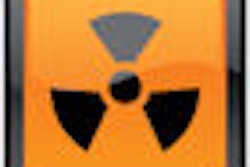In a bid to get ahead of the radiation dose issue, healthcare industry trade group Medical Imaging and Technology Alliance (MITA) of Arlington, VA, today announced the development of a new radiation dose safeguard program.
The program involves software that can be installed on CT scanners to alert operators with a yellow ("warning") or red ("don't scan at this dose level") pop-up screen when recommended radiation dose levels set by the healthcare provider would be exceeded by continuing with the scan, according to Dave Fisher, MITA executive director.
Manufacturers are working on -- or, in some cases, have already implemented -- the new patient safeguards and will be able to include them in new scanners and offer them to their existing customers before the end of 2010, he said, offering details on the program during a February 25 press conference.
"The yellow light is more like an alert -- an 'Are you sure?' question," Fisher said. "The red light dose warning is configurable to prevent scanning. But the feature does not, itself, prevent scanning. The institution that purchases the equipment will have to make a decision during installation as to whether they want to prevent scanning if the dose reaches that level."
Clinicians will set dose threshold levels, which MITA is calling the reference dose, when they install the software, adding threshold levels for new scans as the healthcare facility incorporates them. MITA and its member companies plan to work with professional organizations, regulatory bodies, and individual clinicians to put this feature into practice and establish diagnostic reference dose values, Fisher said.
The reference dose feature is aimed at enhancing existing manufacturer safety measures such as equipment safety standards, protocol development, quality and safety checks, provider education programs, and physician-developed medical guidelines intended to minimize radiation dose as much as possible and to provide even greater degrees of coordination, transparency, and reporting in the delivery of medical radiation, MITA said.
The initiative comes as the U.S. Food and Drug Administration (FDA) is developing a plan to more closely regulate medical radiation dose. Indeed, MITA's press conference was held on the eve of hearings to take place in the U.S. House of Representatives on February 26. MITA believes its program dovetails with these initiatives.
"FDA strongly supports the idea of developing dose reference levels -- we do as well," Fisher said during the news conference. "This signifies that there currently aren't dose reference level standards for all the CT scans that are available. That is why in creating this tool we are leaving the value to the provider, to the customer, to put in that value during the installation process."
The reason MITA designed the system the way it did -- with user-controllable dose levels -- was to give providers input and get the project off the ground quickly, Fisher said.
"We think that this should happen right away rather than waiting for the dose reference levels to be determined for all the different types of scans," he said. "We want to make sure that radiologists and physicists at these institutions have the ability to do it now."
All dose information would be standardized and archivable in a dose registry for further study and tracking, Fisher said. Inasmuch as the Obama administration has included funds for a dose registry in the current proposed federal budget, the software "could be configured to work with the dose registry that Obama is proposing," Fisher said.
Today's initiative follows MITA's recent announcement of eight key principles for reducing unnecessary radiation exposure and medical errors:
- Expanding and integrating appropriateness criteria into physician decision-making
- Creating a national dose registry to ensure longitudinal tracking of dose levels for patients across America
- Adopting a standardized storage of diagnostic imaging information within electronic health records
- Expanding mandatory accreditation for advanced imaging facilities
- Establishing minimum standards for hospital and imaging facility personnel who perform medical imaging exams and deliver radiation therapy treatments
- Developing minimum standards for training and education for hospital and imaging facility personnel and checklists to reduce medical errors
- Expanding and standardizing the reporting of medical errors associated with medical radiation across stakeholders in a manner that is transparent for patients, families, and physicians
- Working with stakeholders to develop radiation dose reference values to provide a data point to compare the dose level of a specific procedure; MITA commits to working with other stakeholders to develop the most appropriate way to incorporate this information into manufacturers' technology
By Eric Barnes
AuntMinnie.com staff writer
February 25, 2010
Related Reading
FDA meeting to address radiation-reduction initiative, February 25, 2010
FDA staff says agency may need new device powers, February 22, 2010
Congressional hearings on medical radiation rescheduled, February 19, 2010
Congress sets hearings to review medical radiation, February 8, 2010
ASTRO commits to patient protection plan, February 4, 2010
Copyright © 2010 AuntMinnie.com



















